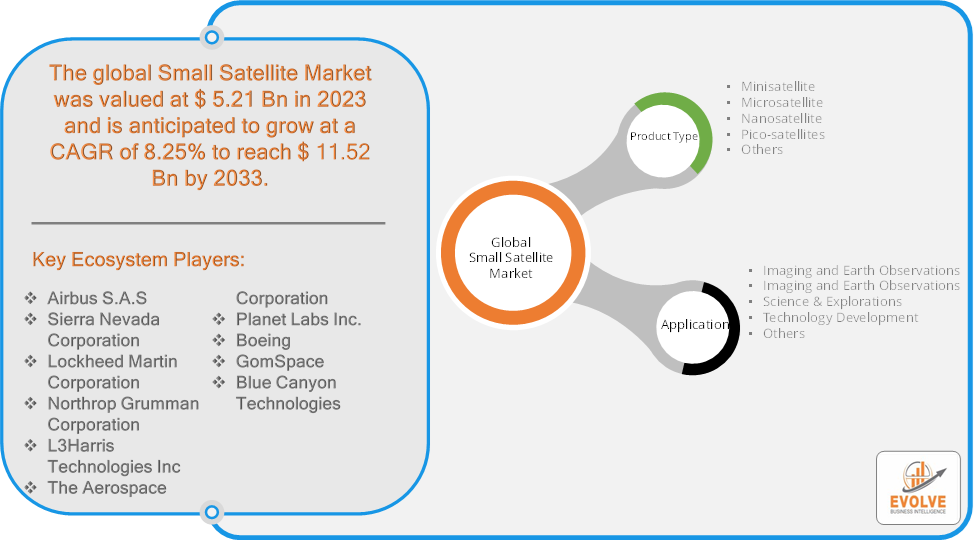Evolve Business Intelligence has published a research report on the Global Small Satellite Market, 2023–2033. The global Small Satellite Market is projected to exhibit a CAGR of around 8.25% during the forecast period of 2023 to 2033.
Evolve Business Intelligence has recognized the following companies as the key players in the global Small Satellite Market: Airbus S.A.S, Sierra Nevada Corporation, Lockheed Martin Corporation, Northrop Grumman Corporation, L3Harris Technologies Inc, The Aerospace Corporation, Planet Labs Inc., Boeing, GomSpace and Blue Canyon Technologies.
 More Information: https://evolvebi.com/report/small-satellite-market-analysis/
More Information: https://evolvebi.com/report/small-satellite-market-analysis/
Market Highlights
The Global Small Satellite Market is projected to be valued at USD 11.52 Billion by 2033, recording a CAGR of around 8.25% during the forecast period. The Small Satellite Market refers to the industry focused on the development, launch, and operation of small satellites, which typically weigh between 100 kilograms (220 pounds) and 500 kilograms (1,100 pounds). These satellites are often used for a variety of purposes, including Earth observation, communication, scientific research, and technology demonstrations.
The Small Satellite Market is an evolving sector with significant potential for innovation and expansion in the coming years. The small satellite market represents a dynamic and rapidly growing sector that is transforming the space industry by providing affordable and flexible solutions for various applications.
The COVID-19 pandemic had significant impacts on the Small Satellite Market. The pandemic caused disruptions in the global supply chain, affecting the production and delivery of components needed for small satellites. Lockdowns and restrictions led to delays in manufacturing and logistics, impacting satellite deployment schedules. The pandemic resulted in delays and cancellations of satellite launches. Restrictions on travel and international collaboration also affected the planning and execution of launches, leading to postponed missions. The economic uncertainty caused by the pandemic led to shifts in investment priorities. Some investors became cautious, which impacted funding for new small satellite projects and start-ups. The pandemic highlighted the importance of satellite technology for global connectivity and remote monitoring. This led to increased interest and investment in small satellites for applications like Earth observation, telecommunication, and disaster response.
Segmental Analysis
The global Small Satellite Market has been segmented based on Product Type and Application.
Based on Product Type, the Small Satellite Market is segmented into Minisatellite, Microsatellite, Nanosatellite, Pico-satellites and Others. The Nanosatellite segment is anticipated to dominate the market.
Based on Application, the global Small Satellite Market has been divided into Imaging and Earth Observations, Imaging and Earth Observations, Science & Explorations, Technology Development and Others. The Earth Observations segment is anticipated to dominate the market.
More Information: https://evolvebi.com/report/small-satellite-market-analysis/
Regional Analysis
The Small Satellite Market is divided into five regions: North America, Europe, Asia-Pacific, South America, and the Middle East, & Africa. North America, particularly the United States, is a leader in the small satellite market. Dominates the global small satellite market due to early adoption, strong technological advancements, and substantial investments in space exploration and focus on advanced technologies, innovative applications, and commercialization. It also has high levels of innovation and significant investment in satellite technology and launch services. Europe is experiencing growth in the small satellite sector, with several companies and research institutions engaged in satellite development and launch. ESA’s support for small satellite missions and partnerships with commercial entities foster market development and an increasing number of start-ups and new entrants are focusing on small satellite technology and applications. The Asia-Pacific region is seeing rapid growth in the small satellite market, driven by countries like China, India, Japan, and South Korea. Rapidly emerging market with growing interest in space technology. Focus on domestic market needs and affordable space solutions and a growing number of private companies are entering the market, supported by favorable regulatory environments and increasing demand for satellite services. The small satellite market in Latin America is developing, with increasing interest from both government and private sectors and growing investment in space infrastructure and satellite technology. The small satellite market in the Middle East and Africa is emerging, with a focus on satellite communications, Earth observation, and regional connectivity and increasing involvement of private companies and start-ups in the satellite industry.